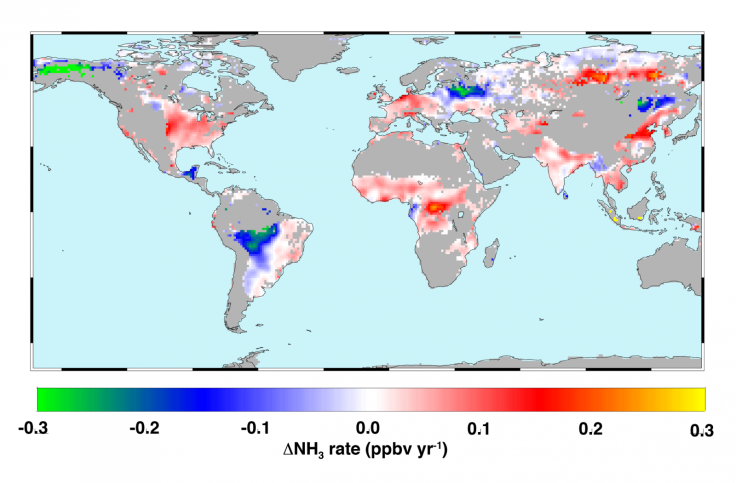Huge clouds of ammonia hanging over world's major farmlands have been detected from space
The US, Europe, China and India are each sitting under huge pools of ammonia in the atmosphere.
Hotspots of the atmospheric pollutant ammonia have been found over regions of the world dominated by intensive agriculture.
The high concentrations of ammonia in the atmosphere were detected by infrared sensors from space by Nasa satellites in the first long-term study of its kind, published in the journal Geophysical Research Letters. The researchers also tracked the most likely sources for the pollution, including farming and changes in atmospheric and soil chemistry.
"[The ammonia] is mainly agricultural, from fertiliser and animal husbandry," said study author Russell Dickerson of the University of Maryland in the US. "It has a profound effect on air and water quality – and ecosystems."
Ammonia is naturally present in the atmosphere in tiny quantities. It is released in much larger quantities by nitrogen fertilisers and animal waste. Warming soils due to climate change also releases more ammonia into the atmosphere.
Once in the atmosphere ammonia can react with nitric and sulphuric acids to form aerosol particles. These particulates have been linked to respiratory problems and cancers in humans. At ground level ammonia also causes problems in rivers, lakes and oceans, contributing to harmful algal blooms and ocean dead zones.
There were pools of ammonia present over four major agricultural centres of the world: the US, Europe, China and India.
"In Maryland, ammonia from the atmosphere contributes as much as a quarter of the nitrogen pollution in the Chesapeake Bay, causing eutrophication and leading to dead zones that make life very difficult for oysters, blue crabs and other wildlife," said Dickerson.
In different world regions, different factors were driving the high levels of ammonia. In the US, regulations to tackle acid rain have had the unintended consequence of boosting ammonia levels, the authors said. Acids help to remove ammonia from the atmosphere, and without them it builds up.
"The decrease in acid rain is a good thing. Aerosol loading has plummeted – a substantial benefit to us all," Dickerson said. "But it has also increased gaseous ammonia loading, which we can see from space."

In China, the pool of ammonia was due to a combination of similar efforts to reduce emissions of acid-creating gases and also the expansion of agricultural land and greater use of fertilisers. In India, the increase was mostly due to more use of fertiliser and growth in the livestock industry.
"As the world's population grows, so does the demand for food, especially meat," Dickerson said. "This means farmers and ranchers need more fertiliser, which makes it harder to maintain clean air and water.
"Wise agricultural practices and reduced greenhouse gas emissions can help avoid adverse effects."

© Copyright IBTimes 2024. All rights reserved.







